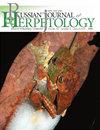西部地区蛇眼龙(Ablepharus kitaibelii)的生态学、种群密度和易位
IF 0.9
4区 生物学
Q3 ZOOLOGY
引用次数: 1
摘要
蛇眼鼬最西部的种群分布在克罗地亚的帕普克,与克罗地亚伊洛克的种群最为接近。到目前为止,还没有对它们中的任何一种的生态学进行研究,在这里,我们记录了它们之间的变化。此外,我们使用样线估计了帕普克的种群密度,并定量评估了其生存能力,即在不同情况下的生存机会;在目前的情况下,随着栖息地的增加,以及灾难性事件(如森林火灾、栖息地退化)的负面影响。我们的研究表明,这两个种群之间的气候差异很大,而这两个地方对物种的其他一般要求保持不变。在帕普克地区,我们估计总人口规模为5036至5483人,相对密度为每公顷97人。种群生存能力结果表明,由于100年来个体数量呈负趋势,帕普克种群很可能灭绝。这意味着种群并不稳定,在目前的条件下,需要采取紧急的保护措施。我们模拟了两种措施,1)通过移除黑松种植园来恢复栖息地,以及2)将蛇眼Skink迁移到两个新的栖息地。这两种方法都依赖于可用栖息地的增加,并且都在研究区域实施。2014年,900平方米的黑松林被砍伐,2014年和2016年,我们每年将100只(共200只)转移到新的栖息地。监测数据证实,新建立的亚群存在于这两个位点,并且正在繁殖,这可能意味着我们的易位可能是成功的。本文章由计算机程序翻译,如有差异,请以英文原文为准。
Ecology, Population Density, and Translocation of the Snake-Eyed Skink (Ablepharus kitaibelii) in Westernmost Populations
Westernmost population of the Snake-eyed Skink is found in Papuk, Croatia, and is the closest to the population from Ilok, Croatia. So far, the ecology of any of them has not been studied, and here, we document the variation between them. Furthermore, we estimated population density in Papuk using line transects, and quantitatively assessed its viability, i.e., chances for its survival under different scenarios; under current situation, with increased habitat, and with the negative effect of catastrophic events (e.g., forest fires, habitat degradation). Our study suggests that the climate between the two populations differs significantly, while other general requirements of the species remain the same in both locations. In the Papuk area we estimated the total population size from 5036 to 5483 individuals, with a relative density of 97 individuals per hectare. The population viability results suggest that the extinction of the Papuk population is likely to happen due to the negative trend in the number of individuals over 100 years. This implies that the population is not stable and under current condition shows the need for urgent conservation measures. We modeled two measures, 1) restoration of habitat via the removal of black pine plantations, and 2) translocation of the Snake-eyed Skink into two new habitats. Both methods rely on the increase of available habitat, and both were implemented in the study area. In 2014 an area of 900 m2 of black pine forest was removed, and in 2014 and 2016 we translocated 100 individuals per year (altogether 200 individuals) into new habitats. Monitoring data confirmed that the newly established subpopulations are present at both sites, and are reproducing, which could imply that our translocation might be successful.
求助全文
通过发布文献求助,成功后即可免费获取论文全文。
去求助
来源期刊

Russian Journal of Herpetology
ZOOLOGY-
CiteScore
1.70
自引率
0.00%
发文量
29
期刊介绍:
Russian Journal of Herpetology is an international multi-disciplinary journal devoted to herpetology. Russian Journal of Herpetology accepts original papers on ecology, behavior, conservation, systematics, evolutionary morphology, paleontology, physiology, cytology and genetics of amphibians and reptiles.
Types of Contributions:
-original papers
-invited or contributed reviews on specific topics
-short communications on topics of immediate interest, new methods and ideas in progress
-notices of meetings, symposia, and short courses
-book reviews
 求助内容:
求助内容: 应助结果提醒方式:
应助结果提醒方式:


